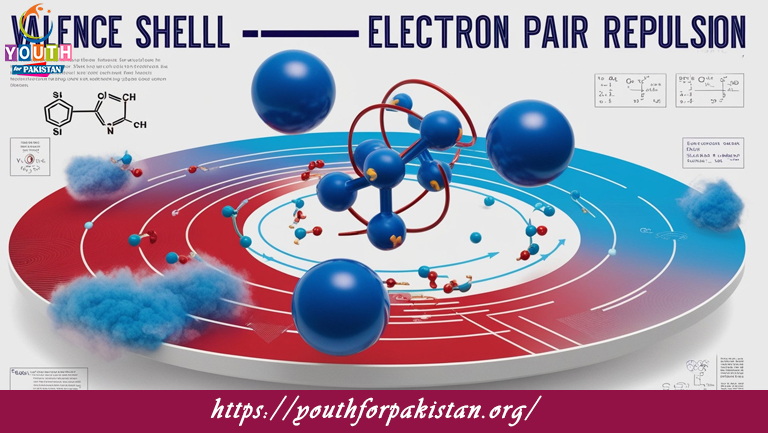The Valence Shell Electron Pair Repulsion Theory MDCAT Quiz

The Valence Shell Electron Pair Repulsion Theory MDCAT Quiz; Because it provides a framework to predict the geometry of molecules based on the repulsion between electron pairs in the valence shell of atoms, VSEPR theory is important for answering questions in the MDCAT Quiz related to molecular shapes, bond angles, and general structure of molecules.
H2: Concept of VSEPR Theory
VSEPR Theory is based on the fact that electron pairs around a central atom will arrange themselves in such a way that they minimize repulsion between each other. The theory assumes that the electron pairs, whether bonding or lone pairs, will spread out as far as possible to achieve the lowest energy configuration. This arrangement leads to specific molecular geometries, which can be predicted based on the number of electron pairs around the central atom. For example, if a molecule has two bonding pairs and no lone pairs, it will adopt a linear shape. On the other hand, molecules with three bonding pairs will adopt a trigonal planar geometry.
H3: Quiz on VSEPR Theory
The MDCAT Quiz on VSEPR Theory will test students’ ability to predict molecular shapes based on the number of bonding pairs and lone pairs around the central atom. Students will be asked to determine the geometry, bond angles, and polarity of molecules like methane (CH₄), water (H₂O), and carbon dioxide (CO₂). The quiz will also cover more complex molecules with multiple bonds, requiring students to understand how lone pairs and multiple bonds affect molecular geometry. Practicing these quiz questions will help students strengthen their understanding of VSEPR Theory and prepare for related questions in the MDCAT exam.
H2: Electron Group Geometries for Molecular VSEPR Theory
VSEPR theory gives a manner in which to predict the geometry of molecules given the number of electron pairs about a central atom. Here are common electron pair geometries:
Linear Geometry: This occurs when there are two electron pairs about the central atom. The bond angle is 180°. An example is carbon dioxide (CO₂), where the central carbon atom is bonded to two oxygen atoms in a linear arrangement.
Trigonal Planar Geometry: This occurs when there are three electron pairs about the central atom. The bond angles are 120°. An example is boron trifluoride (BF₃), where the central boron atom forms three bonds with fluorine atoms.
Tetrahedral Geometry: This occurs when there are four electron pairs about the central atom. The bond angles are 109.5°. An example is methane, CH₄, where the central carbon atom is bonded to four hydrogen atoms in a tetrahedron.
Trigonal Bipyramidal Geometry: This occurs when there are five electron pairs about the central atom; this geometry results in bond angles of 90° and 120°. An example is phosphorus pentachloride, PCl₅, where five chlorine atoms are bonded to the central phosphorus atom.
Octahedral Geometry: Occurs when there are six electron pairs around the central atom. The bond angles are 90°. An example is sulfur hexafluoride (SF₆), where the central sulfur atom is bonded to six fluorine atoms.
H3: Free Flashcard for VSEPR Theory
To help reinforce their understanding of VSEPR Theory, MDCAT students can use the Free Flashcard for this topic. The flashcards provide a concise summary of the different electron pair geometries, their associated bond angles, and examples of molecules that exhibit each geometry. Regular review of the flashcards will help students improve their ability to predict molecular shapes and understand the influence of electron pairs on molecular geometry. This is perfect for quick revision before the MDCAT exam and will ensure that students are well-prepared for related questions.

According to VSEPR theory, how are electron pairs arranged around a central atom?
To minimize repulsion

In VSEPR theory, the electron pairs around a central atom are assumed to be in what shape?
Tetrahedral

What happens when a lone pair of electrons is present in a molecule according to VSEPR theory?
It increases repulsion

What shape does a molecule with 3 regions of electron density adopt according to VSEPR theory?
Trigonal planar

What does VSEPR theory predict about the electron density in a molecule with a bent shape?
It is unevenly distributed

What shape does a molecule with 2 regions of electron density adopt according to VSEPR theory?
Linear

According to VSEPR theory, what kind of electron pairs are involved in creating a bent molecular shape?
Lone pairs and bonding pairs

What is the shape of a molecule with 5 bonding regions according to VSEPR theory?
Trigonal bipyramidal
Experience the real exam environment with our expertly designed collection of over 25,000 MCQs MDCAT Mock Tests.





